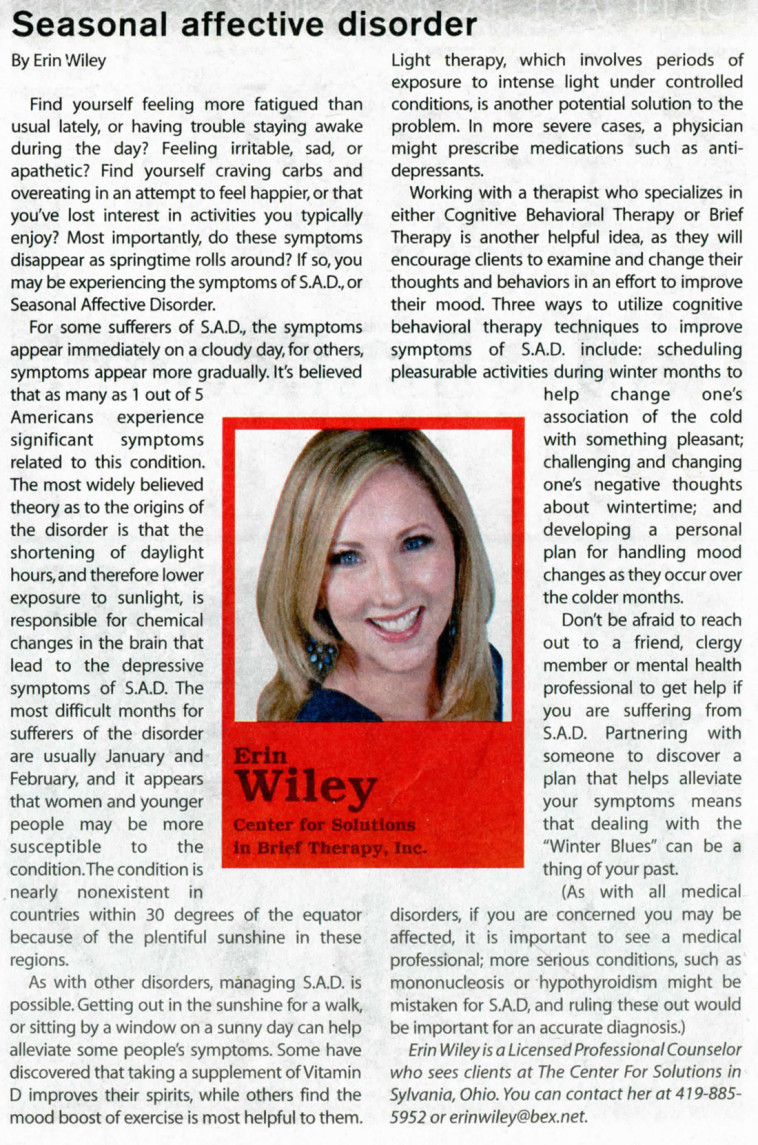As published in Small Business Review, December 2012
by Erin Wiley
Find yourself feeling more fatigued than usual lately, or having trouble staying awake during the day? Feeling irritable, sad, or apathetic? Find yourself craving carbs and overeating in an attempt to feel happier, or that you’ve lost interest in activities you typically enjoy? Most importantly, do these symptoms disappear as springtime rolls around? If so, you may be experiencing the symptoms of S.A.D., or Seasonal Affective Disorder.
For some sufferers of S.A.D., the symptoms appear immediately on a cloudy day, for others, symptoms appear more gradually. It’s believed that as many as 1 out of 5 Americans experience significant symptoms related to this condition. The most widely believed theory as to the origins of the disorder is that the shortening of daylight hours, and therefore lower exposure to sunlight, is responsible for chemical changes in the brain that lead to the depressive symptoms of S.A.D. The most difficult months for sufferers of the disorder are usually January and February, and it appears that women and younger people may be more susceptible to the condition. The condition is nearly nonexistent in countries within 30 degrees of the equator because of the plentiful sunshine in these regions.
As with other disorders, managing S.A.D. is possible. Getting out in the sunshine for a walk, or sitting by a window on a sunny day can help alleviate some people’s symptoms. Some have discovered that taking a supplement of Vitamin D improves their spirits, while others find the mood boost of exercise is most helpful to them. Light therapy, which involves periods of exposure to intense light under controlled conditions, is another potential solution to the problem. In more severe cases, a physician might prescribe medications such as anti-depressants.
Working with a therapist who specializes in either Cognitive Behavioral Therapy or Brief Therapy is another helpful idea, as they will encourage clients to examine and change their thoughts and behaviors in an effort to improve their mood. Three ways to utilize cognitive behavioral therapy techniques to improve symptoms of S.A.D. include: scheduling pleasurable activities during winter months to help change one’s association of the cold with something pleasant; challenging and changing one’s negative thoughts about wintertime; and developing a personal plan for handling mood changes as they occur over the colder months.
Don’t be afraid to reach out to a friend, clergy member or mental health professional to get help if you are suffering from S.A.D. Partnering with someone to discover a plan that helps alleviate your symptoms means that dealing with the “Winter Blues” can be a thing of your past.
(As with all medical disorders, if you are concerned you may be affected, it is important to see a medical professional; more serious conditions, such as mononucleosis or hypothyroidism might be mistaken for S.A.D, and ruling these out would be important for an accurate diagnosis.)
Erin Wiley is a Licensed Professional Counselor who sees clients at The Center For Solutions in Sylvania, Ohio. You can contact her at (419) 345-3326.

